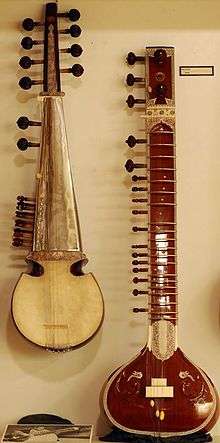Taus (instrument)
The Taus is a bowed string instrument from the north Indian region of Punjab. The taus was invented by Guru Hargobind, the sixth Guru of the Sikhs.[1] The Taus was later modified into the lighter Dilruba by Guru Gobind Singh. It has a peacock body and neck with 20 heavy metal frets. The neck consists of a long wooden rack with 28-30 strings and is played with a bow.
 A Sikh man playing the Taus | |
| Classification | Bowed string instrument |
|---|---|
| Inventor(s) | Guru Hargobind |
| Related instruments | |
Relation to Dilruba/Esraj
The Dilruba originates from the taus and is the creation of the 10th Sikh Guru, Guru Gobind Singh.[2] The Dilruba was designed to be a compact version of the Taus, making it more convenient for the Sikh army to carry on horseback. The Esraj is a modern variant of the Dilruba.
References
- Dharam Singh (2001). Perspectives on Sikhism. Publication Bureau, Punjabi University. p. 158. ISBN 978-8-1738-0736-7.
- Dutta, Madhumita (2008). Let's Know Music and Musical Instruments of India. Star Publications. pp. 22–23. ISBN 978-1-9058-6329-7.
This article is issued from Wikipedia. The text is licensed under Creative Commons - Attribution - Sharealike. Additional terms may apply for the media files.
